JEEP GRAND CHEROKEE 2013 WK2 / 4.G Owners Manual
Manufacturer: JEEP, Model Year: 2013, Model line: GRAND CHEROKEE, Model: JEEP GRAND CHEROKEE 2013 WK2 / 4.GPages: 704, PDF Size: 5.14 MB
Page 241 of 704
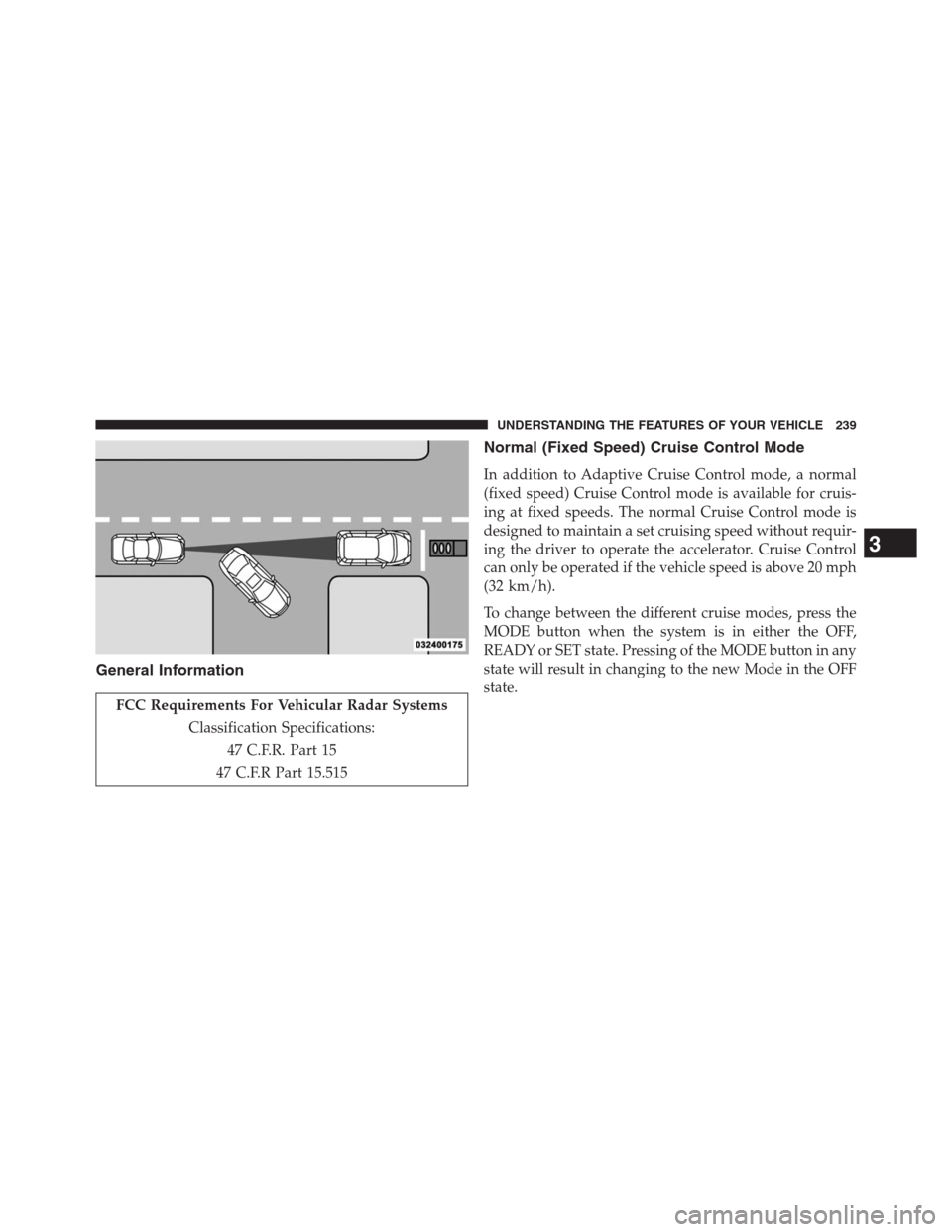
General Information
FCC Requirements For Vehicular Radar Systems
Classification Specifications:
47 C.F.R. Part 15
47 C.F.R Part 15.515
Normal (Fixed Speed) Cruise Control Mode
In addition to Adaptive Cruise Control mode, a normal
(fixed speed) Cruise Control mode is available for cruis-
ing at fixed speeds. The normal Cruise Control mode is
designed to maintain a set cruising speed without requir-
ing the driver to operate the accelerator. Cruise Control
can only be operated if the vehicle speed is above 20 mph
(32 km/h).
To change between the different cruise modes, press the
MODE button when the system is in either the OFF,
READY or SET state. Pressing of the MODE button in any
state will result in changing to the new Mode in the OFF
state.
3
UNDERSTANDING THE FEATURES OF YOUR VEHICLE 239
Page 242 of 704
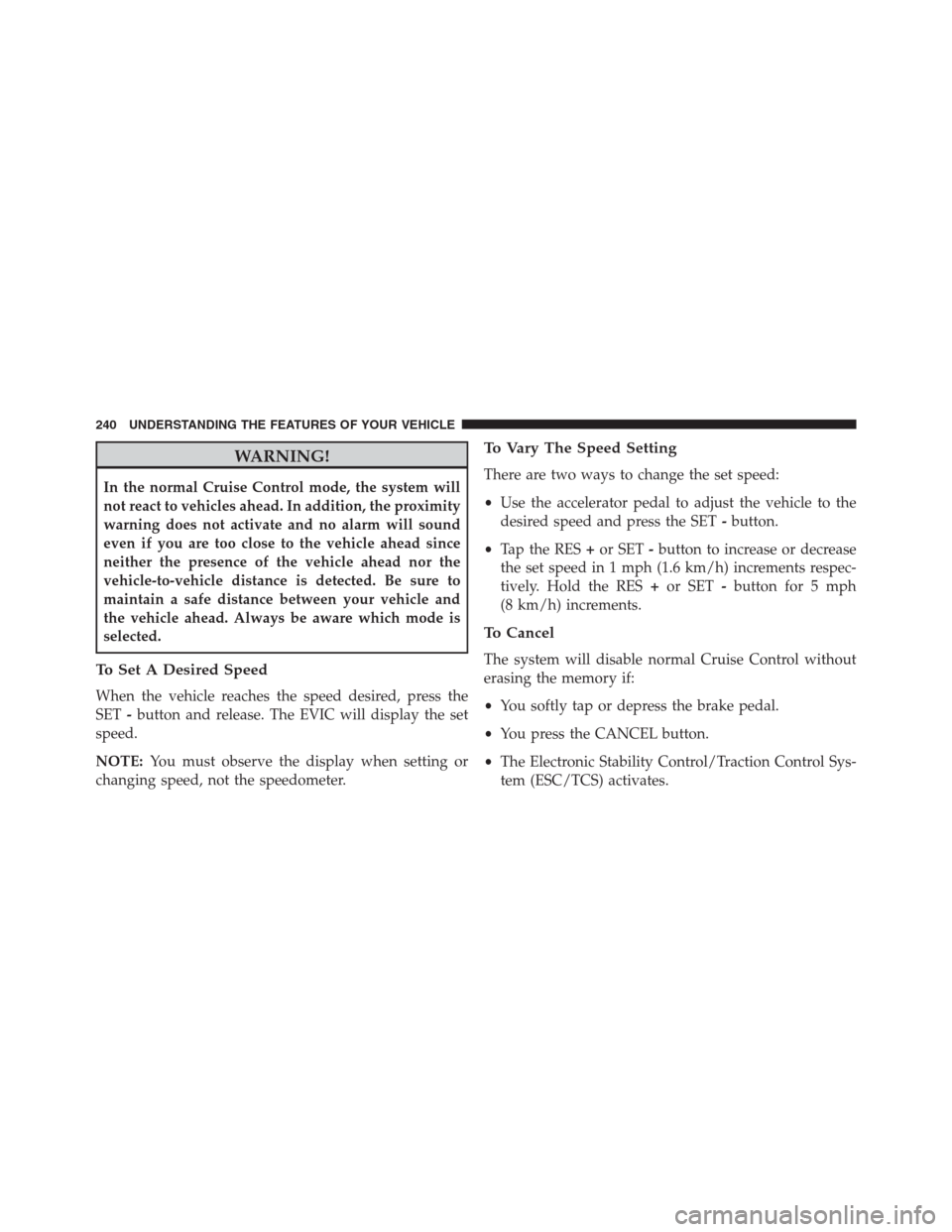
WARNING!
In the normal Cruise Control mode, the system will
not react to vehicles ahead. In addition, the proximity
warning does not activate and no alarm will sound
even if you are too close to the vehicle ahead since
neither the presence of the vehicle ahead nor the
vehicle-to-vehicle distance is detected. Be sure to
maintain a safe distance between your vehicle and
the vehicle ahead. Always be aware which mode is
selected.
To Set A Desired Speed
When the vehicle reaches the speed desired, press the
SET-button and release. The EVIC will display the set
speed.
NOTE:You must observe the display when setting or
changing speed, not the speedometer.
To Vary The Speed Setting
There are two ways to change the set speed:
•Use the accelerator pedal to adjust the vehicle to the
desired speed and press the SET-button.
•Tap the RES+or SET-button to increase or decrease
the set speed in 1 mph (1.6 km/h) increments respec-
tively. Hold the RES+or SET-button for 5 mph
(8 km/h) increments.
To Cancel
The system will disable normal Cruise Control without
erasing the memory if:
•You softly tap or depress the brake pedal.
•You press the CANCEL button.
•The Electronic Stability Control/Traction Control Sys-
tem (ESC/TCS) activates.
240 UNDERSTANDING THE FEATURES OF YOUR VEHICLE
Page 243 of 704
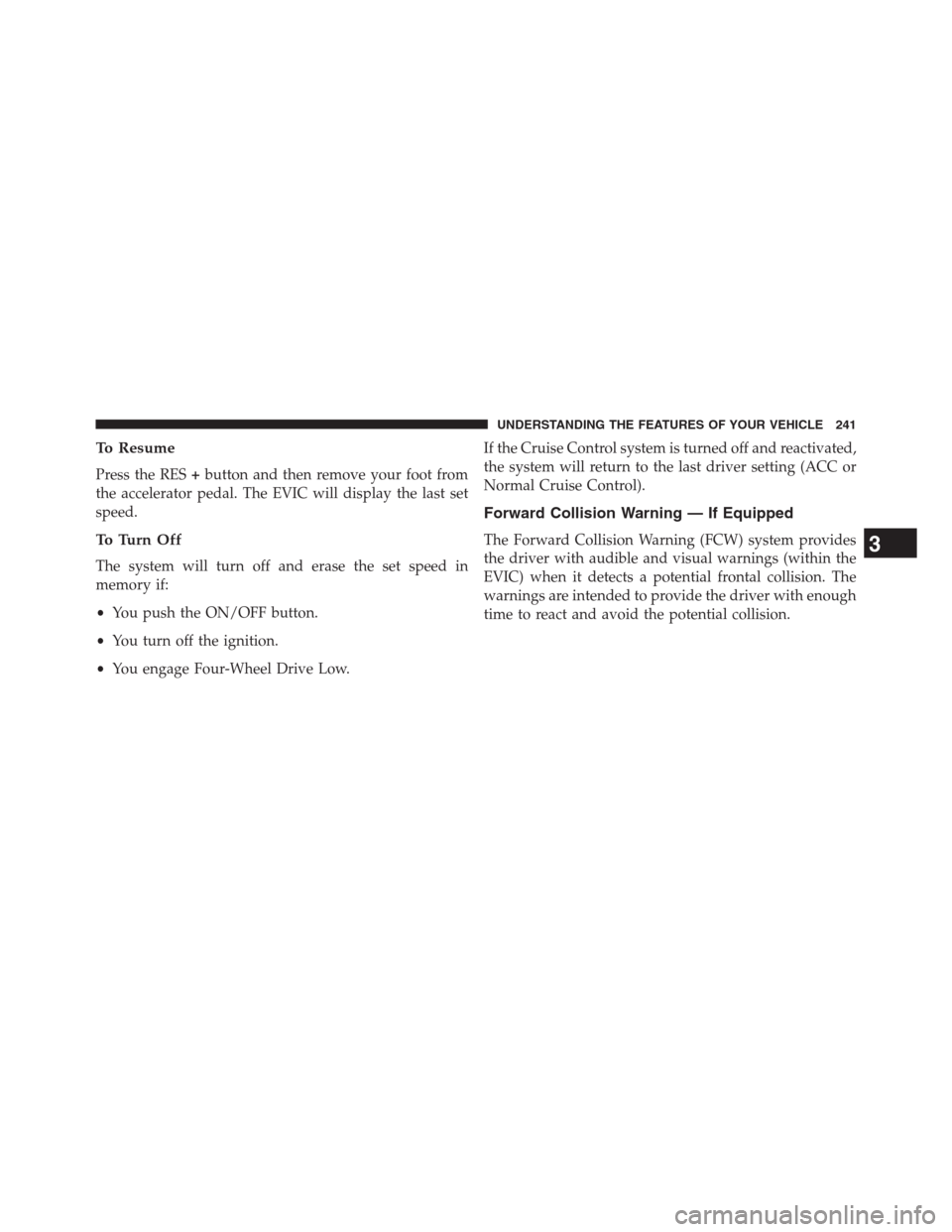
To Resume
Press the RES+button and then remove your foot from
the accelerator pedal. The EVIC will display the last set
speed.
To Turn Off
The system will turn off and erase the set speed in
memory if:
•You push the ON/OFF button.
•You turn off the ignition.
•You engage Four-Wheel Drive Low.If the Cruise Control system is turned off and reactivated,
the system will return to the last driver setting (ACC or
Normal Cruise Control).
Forward Collision Warning — If Equipped
The Forward Collision Warning (FCW) system provides
the driver with audible and visual warnings (within the
EVIC) when it detects a potential frontal collision. The
warnings are intended to provide the driver with enough
time to react and avoid the potential collision.3
UNDERSTANDING THE FEATURES OF YOUR VEHICLE 241
Page 244 of 704
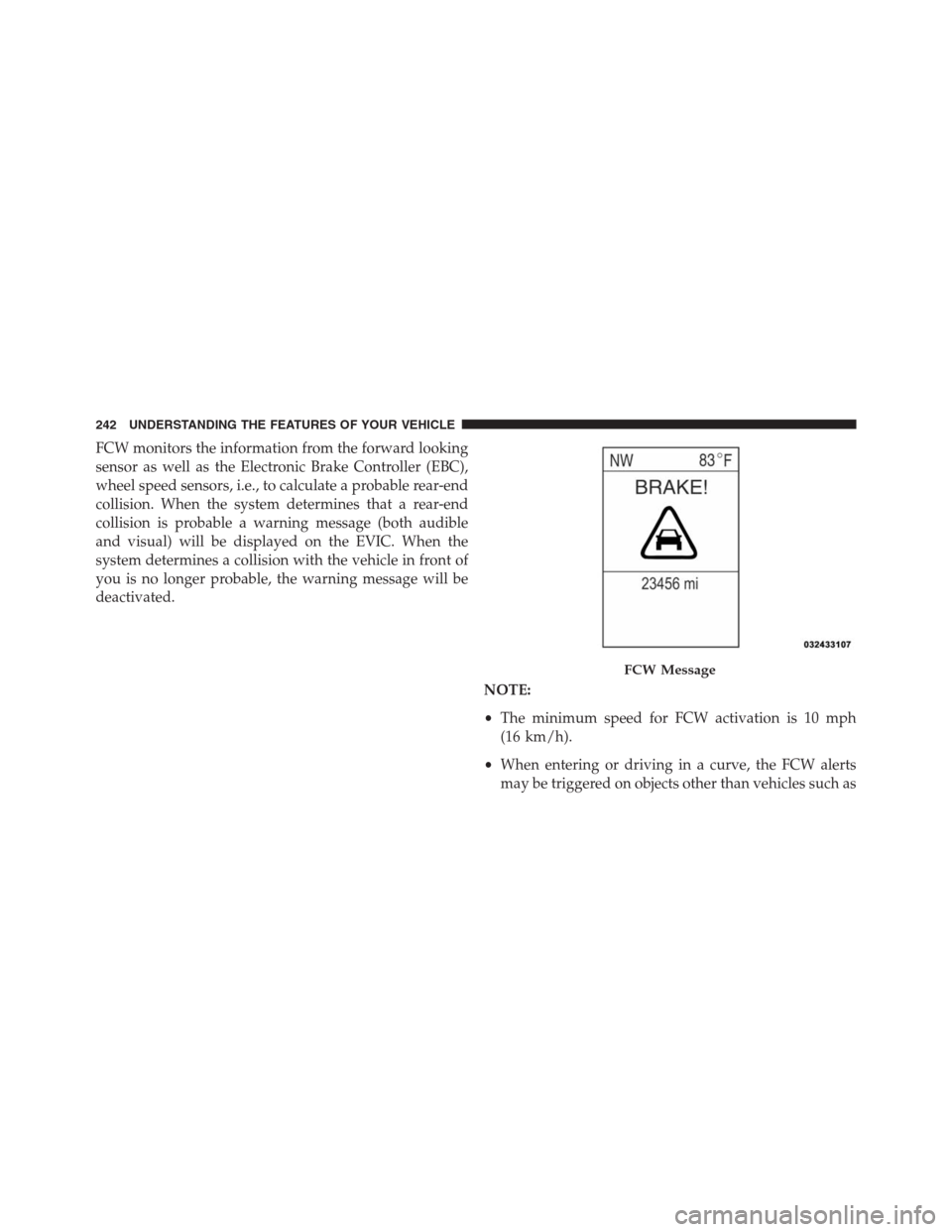
FCW monitors the information from the forward looking
sensor as well as the Electronic Brake Controller (EBC),
wheel speed sensors, i.e., to calculate a probable rear-end
collision. When the system determines that a rear-end
collision is probable a warning message (both audible
and visual) will be displayed on the EVIC. When the
system determines a collision with the vehicle in front of
you is no longer probable, the warning message will be
deactivated.
NOTE:
•The minimum speed for FCW activation is 10 mph
(16 km/h).
•When entering or driving in a curve, the FCW alerts
may be triggered on objects other than vehicles such as
FCW Message
242 UNDERSTANDING THE FEATURES OF YOUR VEHICLE
Page 245 of 704
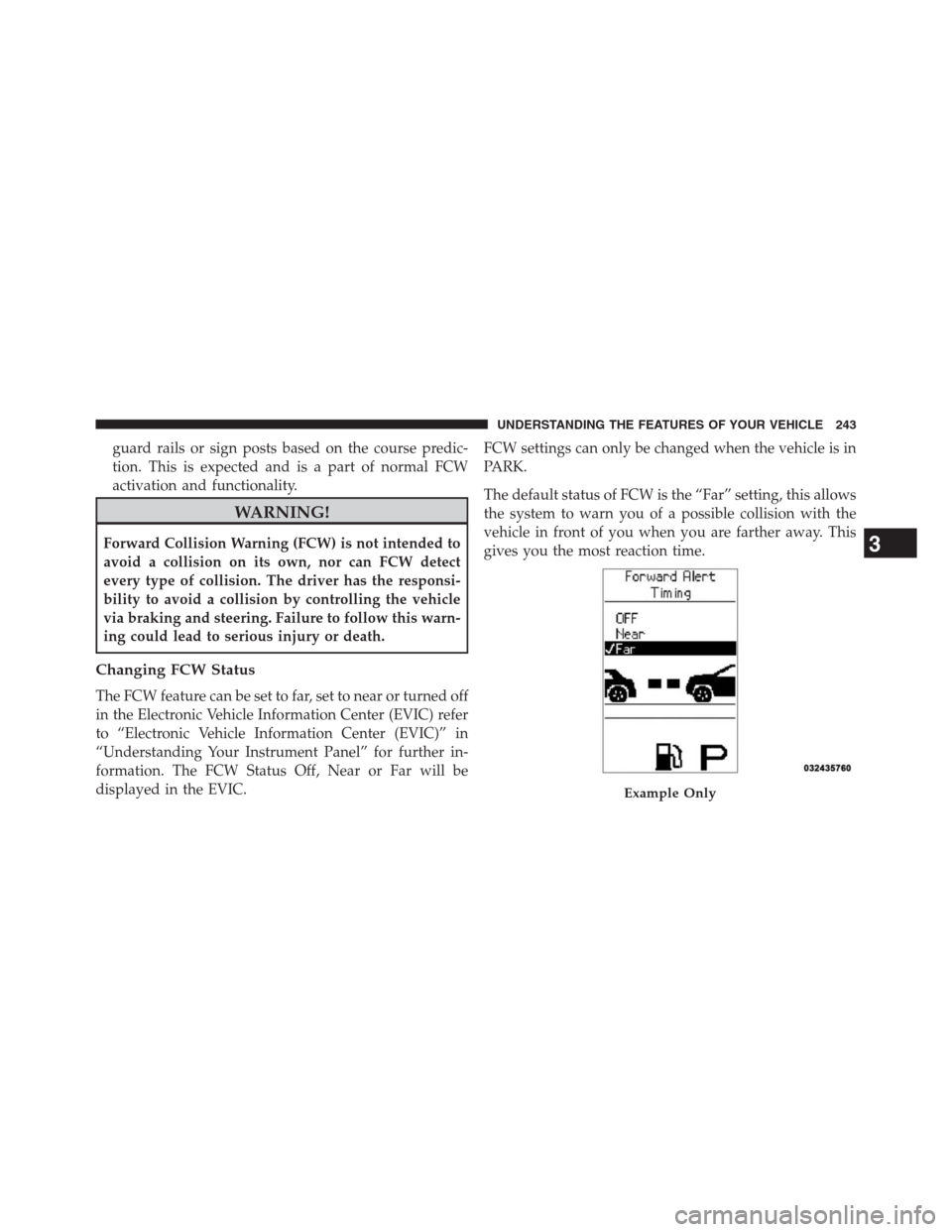
guard rails or sign posts based on the course predic-
tion. This is expected and is a part of normal FCW
activation and functionality.
WARNING!
Forward Collision Warning (FCW) is not intended to
avoid a collision on its own, nor can FCW detect
every type of collision. The driver has the responsi-
bility to avoid a collision by controlling the vehicle
via braking and steering. Failure to follow this warn-
ing could lead to serious injury or death.
Changing FCW Status
The FCW feature can be set to far, set to near or turned off
in the Electronic Vehicle Information Center (EVIC) refer
to “Electronic Vehicle Information Center (EVIC)” in
“Understanding Your Instrument Panel” for further in-
formation. The FCW Status Off, Near or Far will be
displayed in the EVIC.FCW settings can only be changed when the vehicle is in
PARK.
The default status of FCW is the “Far” setting, this allows
the system to warn you of a possible collision with the
vehicle in front of you when you are farther away. This
gives you the most reaction time.
Example Only
3
UNDERSTANDING THE FEATURES OF YOUR VEHICLE 243
Page 246 of 704
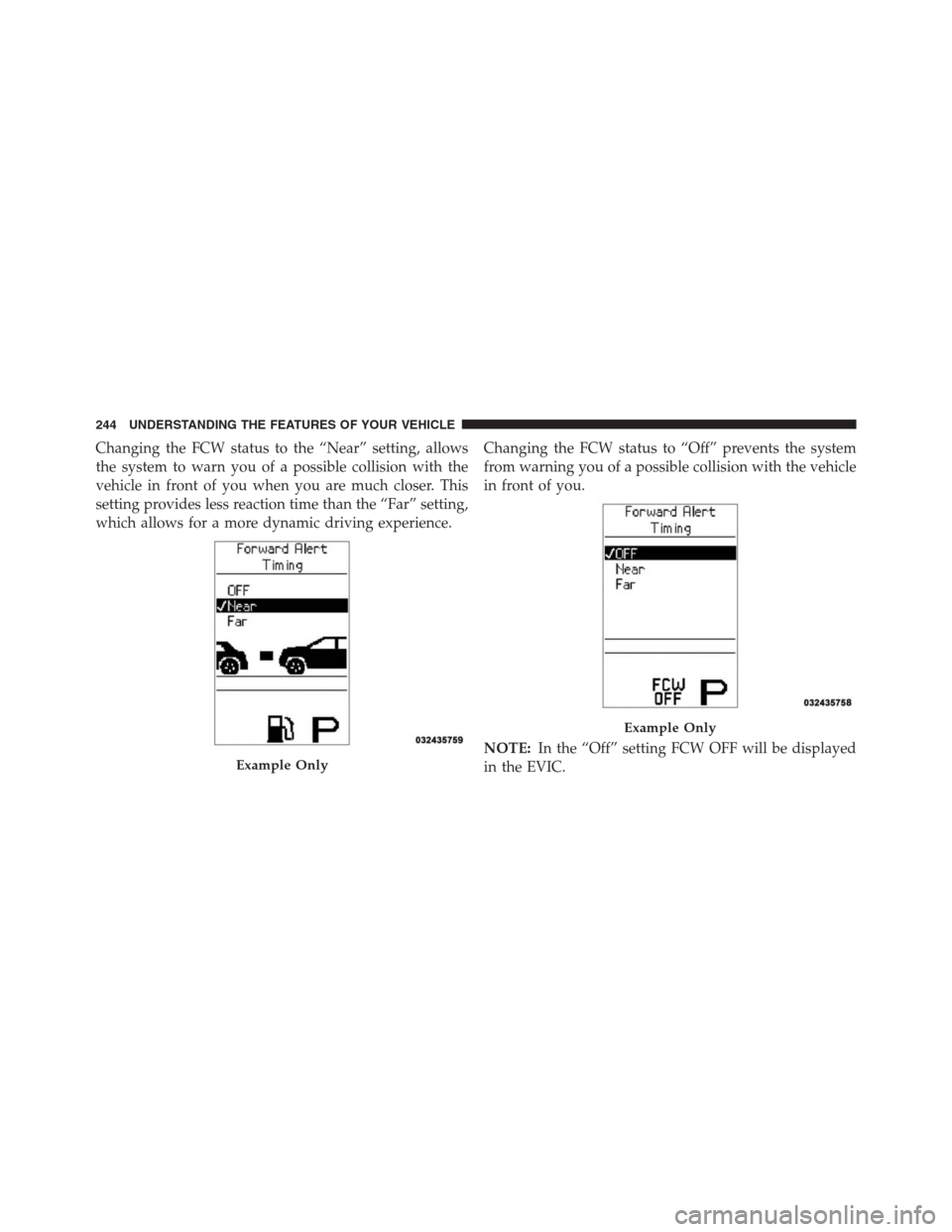
Changing the FCW status to the “Near” setting, allows
the system to warn you of a possible collision with the
vehicle in front of you when you are much closer. This
setting provides less reaction time than the “Far” setting,
which allows for a more dynamic driving experience.Changing the FCW status to “Off” prevents the system
from warning you of a possible collision with the vehicle
in front of you.
NOTE:In the “Off” setting FCW OFF will be displayed
in the EVIC.
Example Only
Example Only
244 UNDERSTANDING THE FEATURES OF YOUR VEHICLE
Page 247 of 704
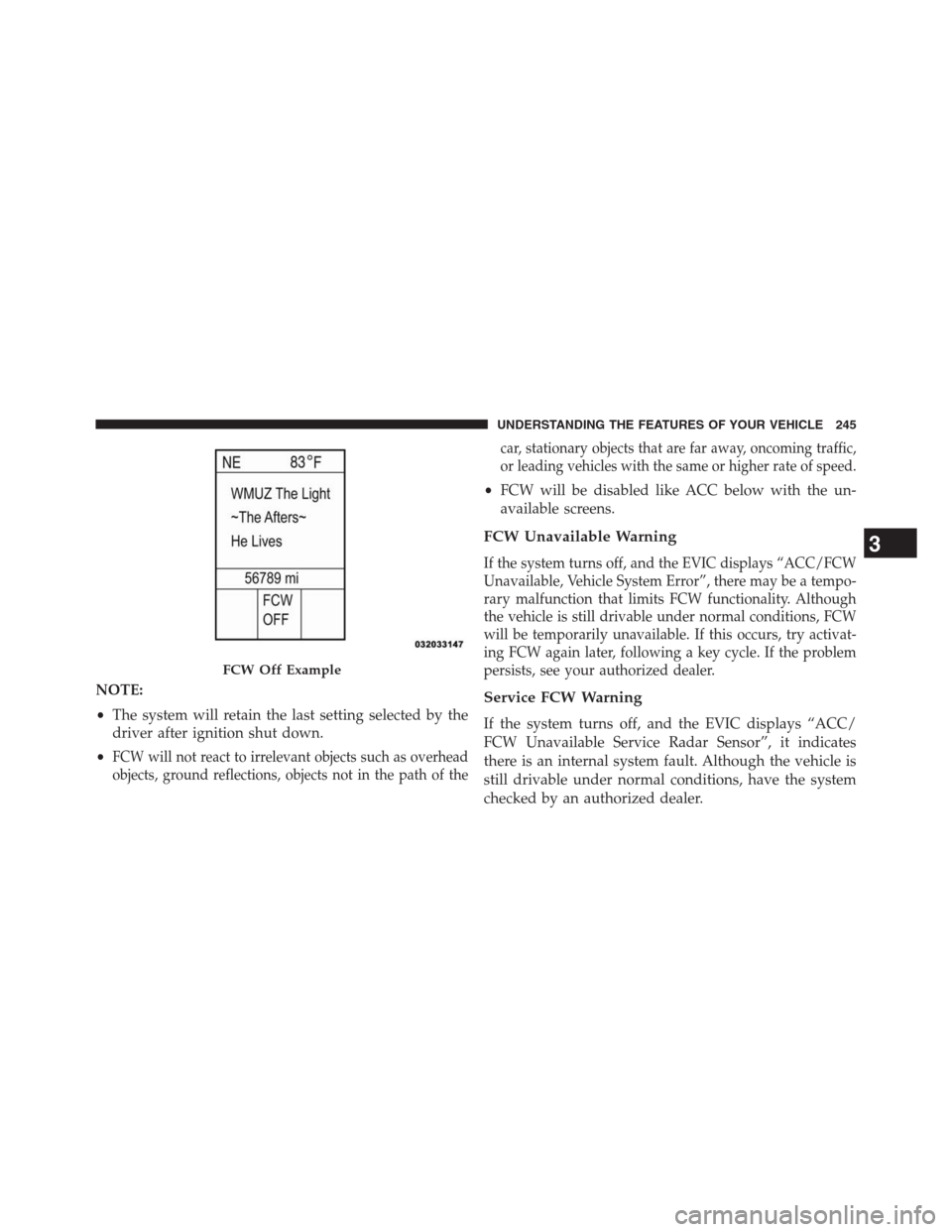
NOTE:
•The system will retain the last setting selected by the
driver after ignition shut down.
•
FCW will not react to irrelevant objects such as overhead
objects, ground reflections, objects not in the path of thecar, stationary objects that are far away, oncoming traffic,
or leading vehicles with the same or higher rate of speed.
•FCW will be disabled like ACC below with the un-
available screens.
FCW Unavailable Warning
If the system turns off, and the EVIC displays “ACC/FCW
Unavailable, Vehicle System Error”, there may be a tempo-
rary malfunction that limits FCW functionality. Although
the vehicle is still drivable under normal conditions, FCW
will be temporarily unavailable. If this occurs, try activat-
ing FCW again later, following a key cycle. If the problem
persists, see your authorized dealer.
Service FCW Warning
If the system turns off, and the EVIC displays “ACC/
FCW Unavailable Service Radar Sensor”, it indicates
there is an internal system fault. Although the vehicle is
still drivable under normal conditions, have the system
checked by an authorized dealer.
FCW Off Example
3
UNDERSTANDING THE FEATURES OF YOUR VEHICLE 245
Page 248 of 704
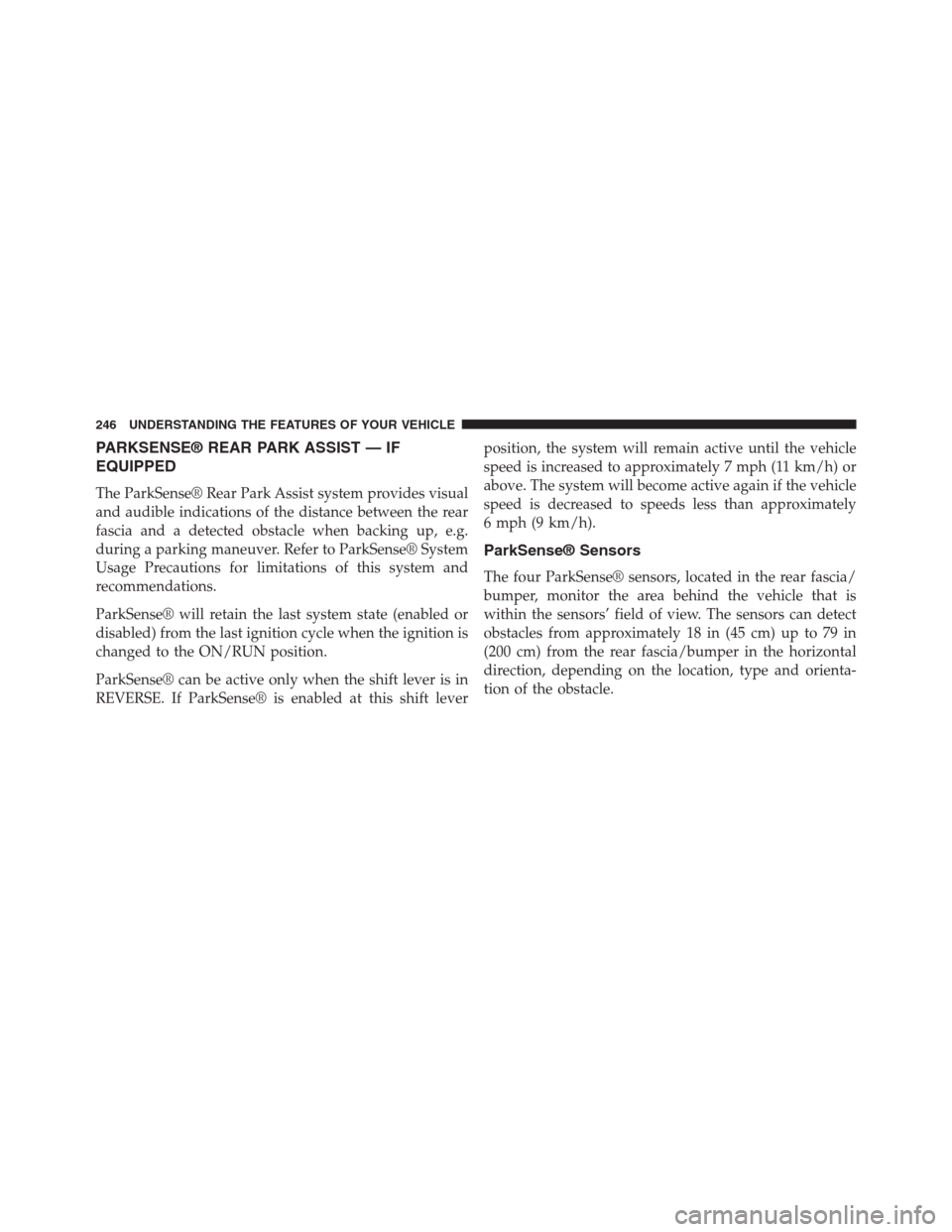
PARKSENSE® REAR PARK ASSIST — IF
EQUIPPED
The ParkSense® Rear Park Assist system provides visual
and audible indications of the distance between the rear
fascia and a detected obstacle when backing up, e.g.
during a parking maneuver. Refer to ParkSense® System
Usage Precautions for limitations of this system and
recommendations.
ParkSense® will retain the last system state (enabled or
disabled) from the last ignition cycle when the ignition is
changed to the ON/RUN position.
ParkSense® can be active only when the shift lever is in
REVERSE. If ParkSense® is enabled at this shift leverposition, the system will remain active until the vehicle
speed is increased to approximately 7 mph (11 km/h) or
above. The system will become active again if the vehicle
speed is decreased to speeds less than approximately
6 mph (9 km/h).
ParkSense® Sensors
The four ParkSense® sensors, located in the rear fascia/
bumper, monitor the area behind the vehicle that is
within the sensors’ field of view. The sensors can detect
obstacles from approximately 18 in (45 cm) up to 79 in
(200 cm) from the rear fascia/bumper in the horizontal
direction, depending on the location, type and orienta-
tion of the obstacle.
246 UNDERSTANDING THE FEATURES OF YOUR VEHICLE
Page 249 of 704

ParkSense® Warning Display
The ParkSense® Warning screen will only be displayed if
Sound and Display is selected from the Customer- Pro-
grammable Features section of the Electronic Vehicle
Information Center (EVIC). Refer to “Electronic Vehicle
Information Center (EVIC)/Personal Settings (Customer-
Programmable Features)” in “Understanding Your In-
strument Panel” for further information.
The ParkSense® Warning Display is located in the Instru-
ment cluster ’s EVIC display. It provides both visual and
audible warnings to indicate the distance between the
rear fascia/bumper and the detected obstacle.
ParkSense® Warning Display
3
UNDERSTANDING THE FEATURES OF YOUR VEHICLE 247
Page 250 of 704
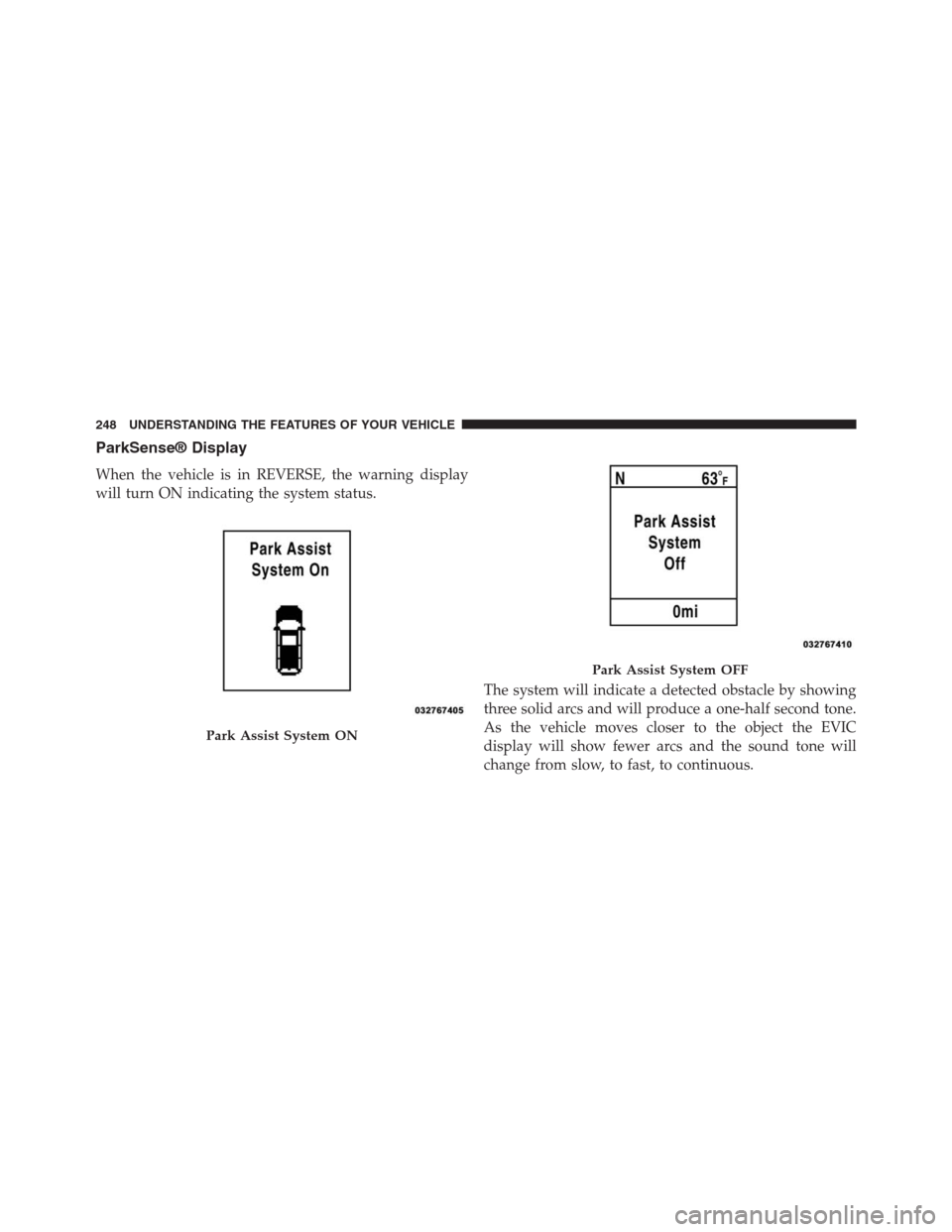
ParkSense® Display
When the vehicle is in REVERSE, the warning display
will turn ON indicating the system status.
The system will indicate a detected obstacle by showing
three solid arcs and will produce a one-half second tone.
As the vehicle moves closer to the object the EVIC
display will show fewer arcs and the sound tone will
change from slow, to fast, to continuous.
Park Assist System ON
Park Assist System OFF
248 UNDERSTANDING THE FEATURES OF YOUR VEHICLE